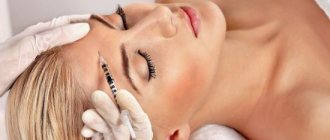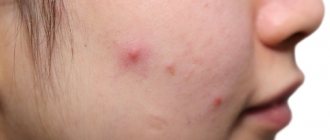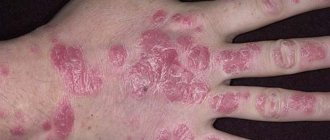A clean and healthy dermis is the dream of many people. Often patients turn to the doctor asking: dark spots on the skin, what are they? Defects can be caused by different pathogens. They indicate a disruption in the functioning of internal organs, but sometimes arise due to external factors. Dermatologists will explain how to get rid of unpleasant formations.
Main types
When dark formations are discovered, every person wonders what it could be. The spots can be flat or convex, small or large, regular or uneven in shape. The defects need to be shown to a doctor, he will conduct a diagnosis and, if necessary, prescribe treatment.
Freckles
The rashes are called sun-kissed rashes or ephelides. In the Middle Ages, it was believed that freckles were marks of evil spirits; freckled people were recognized as witches or sorcerers. Subsequently, freckles were considered a cosmetic defect, only in our time hemp is recognized as a highlight and they rarely try to get rid of it.
Dark spots on the skin of the face, neck, shoulders and back measuring 0.5-1 mm in diameter. The shape is round, the edges are clearly defined. Freckles do not harm health and do not degenerate into cancer. Mostly appear in fair-skinned people with red hair or blondes. The first dark spots appear at 3-4 years of age and disappear completely by 40 years of age.
Lentigo
They are benign hyperpigmented areas on the body. Can be single or multiple. The size ranges from a few millimeters to ten centimeters in diameter. Color varies from beige to dark brown. Dark spots on the body are flat, round or oval in shape. Appear on different parts of the body.
There are several types of lentigo:
- youthful – inherent in young people;
- senile – appears in older people due to age-related changes;
- solar – skin reaction to ultraviolet radiation.
Lentigo can develop into melanoma; according to statistics, this happens in 3% of cases. Constant monitoring by a dermatologist is required.
Chloasma
This is an uneven area of increased pigmentation with clear edges. Most often it is localized on the face: on the forehead, temples, wings of the nose, upper lip. Chloasma is flat, color is brown. Causes psychological discomfort.
Dark spots on the body indicate that there is a malfunction in the body. There is no point in treating them until the causes of their appearance are clarified. Chloasma can appear due to genetic failures, problems in the digestive or reproductive system. It often occurs in pregnant women and menopausal women.
Edema
The constant appearance of swelling on the skin can signal another thyroid disease - hypothyroidism. It occurs when the thyroid gland stops producing enough hormones and is accompanied by symptoms such as paleness and puffiness, especially on the face and eyelids. Also, often with hypothyroidism, the skin begins to peel, hair begins to fall out, and sweating becomes less intense. If any of these symptoms occur, you should make an appointment with an endocrinologist.
Other diseases
- Moles – they are also called nevi or birthmarks. These are benign dark spots on the skin of the arms, legs, face, torso or other parts of the body. Nevus can be brown, beige, red, black and even purple. They usually have a regular round or oval shape (they are less common with irregular shape and uneven coloring, they can degenerate into oncology). They are flat and slightly raised above the skin. Usually there are up to 20 moles on the human body, but sometimes over 100 are found.
- Becker's nevus is a large dark spot on the skin with increased hair growth. The reasons for the appearance are unknown. A nevus never develops into a tumor; it most often occurs in teenage boys on the legs and lower torso. The defect grows slowly, the initial color is light brown, but during tanning it becomes very dark. It rises slightly above the skin and, when examined, looks like a large wart.
- Dubreuil's melanosis is flat nevi with a diameter of 2 to 6 centimeters. He has a high risk of degeneration into melanoma. The shape of the nevus is uneven, similar to a geographical map. The edges are torn. The color is uneven, there are bluish, purple or black inclusions. If you look closely, you will notice many small nodules.
- Acanthosis nigricans is a dermatological pathology in which the skin in the folds darkens and becomes rough. Appears on the neck, under the arms, in the groin area. The dermis in the folds darkens, gradually turning black. She becomes rough and rough. Papillomatosis may appear. The affected areas are slightly itchy, and moderate and aching pain is possible.
- Melanoma is a malignant neoplasm. Under favorable conditions, it degenerates from moles, lentigines and other spots. Melanoma has an irregular shape and uneven coloration. The tumor bleeds, hurts, burns. With timely treatment, doctors promise a favorable prognosis.
Photos of different spots and the name of the disease can be found on thematic resources. All information is provided for general development.
Which doctor should I contact?
If there is widespread or limited discoloration of the skin, you should consult a dermatologist. After ruling out skin diseases, the patient is usually referred to a general practitioner, where he undergoes an examination of the internal organs. After clarifying the diagnosis, a consultation with a specialized specialist is scheduled: endocrinologist, gastroenterologist, hepatologist, hematologist, oncologist.
The disease acanthosis nigricans was described in the 9th century and is considered quite rare. The development of acanthosis is accompanied by the appearance of areas of hyperkeratosis in the area of natural skin folds. In these areas, increased pigmentation and skin papillomatosis are found. Large folds of skin are usually affected - the armpits, groin and neck. Timely detection of acanthosis in the early stages can indicate serious processes. Why acanthosis is dangerous and how to recognize it, read on estet-portal. com.
Spots under the arms
While shaving, people notice that a dark formation has appeared under the armpit or under both. Pigmentation in the armpits is common.
The main reasons are as follows:
- Dark spots under the arms are the result of frequent shaving. The skin there is very delicate; with constant contact with the blade, it gets injured and ingrown hairs appear. All this contributes to coarsening.
- Failure to comply with personal hygiene rules and accumulated dirt leads to the appearance of spots.
- Fungal infections lead to candidiasis, erythrasma, and rubromycosis.
- Diseases of the liver and gallbladder lead to dark spots appearing under the armpits.
What symptoms indicate acanthosis? Forms of acanthosis nigricans
Acanthosis has several forms of progression depending on the cause, which determines the intensity of the development of the process. Dermatologists have identified 3 main forms of acanthosis nigricans:
- Juvenile or benign, which is associated with endocrine and genetic pathologies.
- Malignant or paraneoplastic, which develops with malignant tumors of internal organs.
- Pseudoacanthosis, which develops with obesity and metabolic disorders. This form disappears without a trace when weight is normalized and has the best prognosis.
Clinical manifestations of acanthosis have 3 main symptoms:
- Increased pigmentation - the appearance of black or dark brown spots on the skin.
- Papillomatosis is the presence of fibromas or papillomas on the skin, which are popularly called warts.
- Hyperkeratosis, which provokes roughening and exfoliation of the skin.
Defects in the groin
Dark spots on the skin between the legs appear for the following reasons:
- fungal pathologies;
- age-related skin changes;
- hormonal changes or disruption of the endocrine system;
- disturbances in the functioning of the liver, gall bladder and other digestive organs;
- wearing synthetic and uncomfortable underwear;
- using inappropriate skin care products;
- frequent shaving or other methods of hair removal.
If the skin has darkened due to external reasons, then it can be whitened at home using special creams or traditional methods. Cosmetologists promise faster and more reliable results.
Causes of dark spots on the skin
Dark spots of different types and colors appear on any part of the body, regardless of age and gender.
Causes:
- increased deposition of melanin in the skin (melanosis);
- pigmentation disorder caused by metabolic disorders.
Melanoses appear against the background of chronic or severe diseases of internal organs - failures provoke the accumulation of melanin in the tissues of the epidermis. You can see what different types of nevi look like in the video.
What diseases are accompanied by darkening of the skin:
- congenital or acquired pathologies of the endocrine system, develop when the functioning of the adrenal glands, gonads, or diabetes mellitus is disrupted;
- liver dysfunction – hepatitis, cirrhosis;
- chronic renal failure;
- severe types of tuberculosis.
Arsenic melanosis is a consequence of long-term use of arsenic-based drugs, or constant human contact with toxic substances in hazardous industries.
Important! One of the main reasons for the formation of brown spots of different shades without signs of hair growth is age-related pigmentation disorders, which are more often observed in older people, which is why pigment spots on the face and hands are called the first harbingers of old age.
Hyperpigmentation
Dark spots or areas appear in small areas, cover the entire body, and are formed due to the accelerated synthesis of melanin by pigment cells that are found in the tissues of the epidermis.
Chloasma
Chloasma appears on the skin as a consequence of pathologies of the female reproductive system
Chloasma is a female disease that develops with high estrogen levels against the background of ovarian dysfunction, during pregnancy, and during menopause. Many yellow-brown, sometimes burgundy, irregularly shaped spots appear on the nipples, in the groin area, under the mammary glands, on the face; in winter and autumn, the rashes fade.
PVG
Most often, post-inflammatory hyperpigmentation is a consequence of chemical exposure to the skin.
Post-inflammatory hyperpigmentation is a consequence of trauma, burns, the use of aggressive skin care products, acne and psoriasis. The appearance of rashes is provoked by the removal of facial hair using chemicals or creams with aggressive ingredients. The spots are temporary and gradually disappear on their own.
Lentigo
Lentigo spots look similar to freckles, but are caused by hormonal imbalances.
Lentigines are small spots of brown, light brown color with a smooth surface, of benign origin, but if injured they can develop into melanoma. They are similar in appearance to freckles, but lentigines do not change color under the influence of ultraviolet radiation, they have clearer boundaries, but only a specialist can find the differences. Spots can be found on the nose, limbs, and neck. The typical age for their education is 55 years.
Hormonal imbalance can provoke the appearance of spots, so lentigo often appears during pregnancy and menopause, at puberty, in women who take oral contraceptives.
Leopard syndrome - several hundred lentigines are present on the body, arms and legs, the disease is accompanied by heart problems, retardation in mental and physical development, and deafness. The cause of the disease is a gene mutation.
Important! Lentigo can be a sign of gene mutations and immune disorders. AIDS, the presence of papillomavirus in the body, occurs after sunburn in childhood, organ transplantation.
Dermatological pathologies
Skin diseases, acne, pimples can provoke increased pigmentation and leave behind dark spots.
Acne and pimples can cause skin hyperpigmentation
What skin diseases can cause spots to appear:
- Acanthosis nigricans (acanthosis nigricans) - large spots of dark color with a velvety surface, their appearance is caused by rapid cell division against the background of high levels of insulin and the use of certain medications. Location: limbs, neck, armpits.
- Pityriasis versicolor is a fungal disease that appears as dark or light spots.
- Skin cancer - with carcinoma or melanoma, spots form from pale brown to black, less often they have a pink or red tint. Outwardly they resemble a birthmark, but they grow actively, have symmetrical borders, and bleed.
- Poikiloderma is a congenital form of the disease that is more common in women and is accompanied by cataracts and poor condition of nails, hair, and bones. The acquired form is a consequence of endocrine pathologies, oncological processes, diseases of connective and muscle tissue. In men, spots of different shades appear on the face, torso, and sometimes on the penis, the skin swells and turns red.
Erythema reticularis or toasted skin syndrome - similar spots occur in people who often hold a laptop on their thighs, they appear under the influence of radiation heat.
Becker's nevus
Becker's nevus is characterized by the presence of hair on a pigmented area of the skin
The spots are irregular in shape, pale yellow or dark brown in color, with uneven edges, with a lot of hair growing on the surface, most often formed in boys aged 10–15 years.
Becker's melanosis can be found on the chest, back, abdomen, scalp, legs, shoulders; the spot is initially small in size, but quickly grows and can reach 20 cm in diameter. The reasons for the appearance of nevus are not fully understood, but doctors are inclined to believe that the spots are of hormonal origin; other experts claim that the appearance of spots is associated with exposure to aggressive ultraviolet radiation.
Important! Becker’s nevus is a hereditary disease, so such spots do not always indicate the presence of problems in the body.
Cancerous forms of melanosis
Dubreuil's melanosis - small spots of a blurred shape, slightly convex, rise above the surface of the skin, have a dark brown, sometimes black color; the disease is classified as a precancerous condition. At the initial stage, the size of the nevus does not exceed 5 cm, but gradually increases to 10 cm or more.
Dubreuil's melanosis is a signal of a precancerous condition of the body
Why does melanosis occur?
- age-related skin changes;
- light, thin skin with increased photosensitivity;
- frequent skin damage;
- prolonged exposure to the harsh sun;
- Ignoring moisturizing skin care products.
The spot has clear contours, nodules and small erosions form on it; as the disease develops, the surface of the nevus darkens, becomes denser, and flakes off. Around the pigmented area, the skin becomes red, many new freckles and small areas with signs of keratosis are formed. Such changes occur during the transition of Dubreuil's nevus to the malignant stage.
Dubreuil's melanosis often degenerates into melanoma, usually within 10–15 years after the spot appears; the pathology most often develops in women over 50 years of age.
Acanthosis nigricans is a rare pathology in which dark brown, black spots with pimples are formed. The rashes are located in the armpits, on the sternum in women, on the buttocks, knees, and on the back of the head. The disease develops against the background of endocrine problems, taking hormonal and some other medications; a nevus can signal the presence of cancerous tumors in the body.
Mastocytosis
Mastocytosis most often occurs in children
A pigmented type of urticaria, more common in children. Initially, dark red or pink spots that are very itchy, transform into bubbles with liquid - outwardly everything looks like a burn. After opening the rash, areas of a dark brown color remain on the skin, but in 70% of cases they appear on their own.
The main causes of the disease are hereditary factors, long-term infectious processes, exposure to toxic substances, stress, and climate change.
In adults, the disease occurs in a more severe form, complicated by systemic mastocytosis, which causes disability or death.
Recklinghausen's disease
Recklinghausen's disease develops not only on the skin, but also affects internal organs
With the disease, areas of gray-blue or various shades of brown appear, or atypical clusters of freckles in the form of clusters; rashes can be found in newborns, preschoolers, and gradually there are more of them.
As the disease develops, neurofibromas form on the body, and then on the internal organs, which in 20% of cases degenerate into cancerous tumors. Without proper treatment, the pathology progresses, affecting the nervous and musculoskeletal systems, mental disorders, epilepsy, depressive states, and vertebral defects develop.
Peutz-Jeghers syndrome
In the photo, Peutz-Jeghers syndrome is often a symptom of intestinal problems
On the skin and mucous membranes you can find small round areas up to 4 mm in size of yellow, light or dark brown color; in the mouth and nasopharynx they have a blue-violet tint. The disease is hereditary and occurs more often in women.
Rashes indicate the presence of polyps in the intestines; a person is bothered by abdominal pain, diarrhea, bloating, and rumbling. The spots often degenerate into malignant neoplasms.
Location: skin around the lips and eyes, backs of the hands, forehead, chin, area between the legs.
Treatment
The therapy is prescribed by doctors, but if the defects are caused by external factors, then you can use the advice of traditional medicine. The following recipes are common among them:
- Lemon juice will help people who don’t know how to remove dark spots under their arms. You need to take a piece of citrus and rub it on the problem area of the skin. After twenty minutes, wash the cavities with warm water and lubricate with nourishing cream.
- Mix a little water with two teaspoons of baking soda until you get a paste. Apply the scrub to problem areas. Massage for 2 minutes, then rinse.
- For people who are looking for ways to get rid of dark spots under their arms, juice from raw potatoes will help. You need to soak a compress in it, apply it to the pigmented area for half an hour, then rinse it off.
Before using the advice of traditional medicine, you should consult a doctor. This treatment is combined with traditional therapy. Initially, you should make sure that there are no allergic reactions to the ingredients of masks and scrubs.
Darkening
Darkening of the skin may indicate the development of Addison's disease - chronic insufficiency of the adrenal cortex. And, I must say, this symptom may appear several months earlier than others. Therefore, if you immediately notice darkening, you can immediately consult a doctor and spend much less time, effort and money on treatment. Typically, the skin darkens throughout the body, most clearly visible on the bends of the elbows, knees and fingers. And one more thing: scars that appear during the disease are usually brighter than other areas of the skin. Addison's disease can end very badly, even death, so if darkening is detected, immediately contact an endocrinologist.
How to get rid of black marks on the body due to gold jewelry
What should you do if washing with soap and water does not help, but blackness remains on your hands, ears and neck? There are several options:
- Use high-quality cosmetics. You can't skimp on your health.
- Clean jewelry from dust and dirt. It is recommended not only to periodically clean the gold, but also to disinfect it with alcohol.
- Hide with foundation. This solution is suggested if you don’t want to look at the blackening at all and want to look as presentable as possible.
- When doing housework (washing dishes, cleaning, etc.), jewelry should be removed.
- Prolonged contact of the skin with metal causes bad consequences, so it is necessary to remove jewelry before going to bed.
The correct choice of composition and compliance with the above recommendations will help you forget for a long time about blackening of the skin from gold jewelry.










